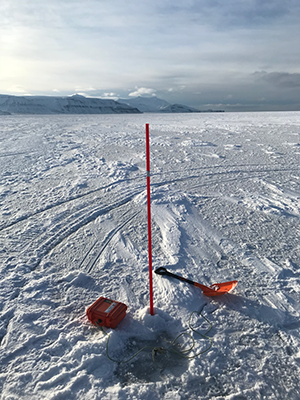Professor Atle Jensen from the Mechanics section is the head of a project called “Dynamics Of Floating Ice” (DOFI). His research group of ten people consisting of scientists, Master and PhD students from the Mechanics section, along with scientists from collaborating institutions, are heading for a week-long expedition to Svalbard at the end of March. Their destination is Tempelfjorden, which is located about an hour snowmobile ride from Longyearbyen. This fjord is particularly well suited for their research due to its exposure to waves combined with adequate ice conditions at this time of the year.
The ROV
The researchers believe the key to understand the energy transfer from waves to sea ice lies within the boundary layer at the interface. This is where the ROV will play its part. It will be submerged underneath the ice to take pictures of particles moving in the boundary layer. Through image processing technology one can calculate the velocity field in the water. The measurement method called Particle Image Velocimetry (PIV) is well known and frequently used under controlled conditions in laboratories. To apply this method in the field by means of an ROV is rather new and exciting.
The team will utilize other measurement instruments in addition to the ROV. An Acoustic Doppler Current Profiler (ADCP) will measure the flow field induced by waves and ocean currents underneath the sea ice. Postdoc Jean Rabault from the Department of Mathematics has designed and produced several Inertial Motion Units (IMU), which shall be placed in an array to measure how the waves are damped as they propagate in the longitudinal direction of the fjord. A portable weather station will provide meteorological information. The acquired data will hopefully provide answers on how wave energy is dissipated in the sea ice.
Arctic expedition

Fieldwork on Svalbard takes a lot of preparations concerning safety, equipment and logistics.
- You can think through all details in advance, but unpredicted challenges always arise in such a harsh and remote environment, says Professor Jensen, who has leaded several previous expeditions.
The safety of the group does not only depend on the ice thickness and its ability to support the weight of the crew, one must also consider the risk of encountering polar bears.
Master student Thea Josefine Ellevold has previously been on exchange to The University Centre in Svalbard (UNIS, which is one of the collaborating partners in the project) and is particularly looking forward to travel back to the island.
- To carry out research in such a special scenery is pretty unique, says Thea.
PhD candidates Yiyi Whitchelo and Trygve Kvåle Løken who will travel to Svalbard for the first time are also excited about the upcoming field trip. They are both involved in the project and are responsible for most of the measurements and data post processing.
Climate research
The upcoming activities on Tempelfjorden can be characterized as fundamental research as the team will investigate the details behind physical mechanisms. However, the answers sought by the group may enlighten and be applied in practical problems. The energy transfer between the atmosphere and the ocean is of great importance in climate and weather forecast models. This information is of interest to The Norwegian Meteorological Institute, which is one of the project stakeholders. Improved forecast models can further impact global ship traffic and help mitigate the risk associated with human activities in the Arctic.
Contact
One of the following project members can be contacted for questions:
- Atle Jensen, Professor: atlej@math.uio.no
- Jean Rabault, Postdoc: jeanra@math.uio.no
- Yiyi Witchelo, PhD candidate: yiyiw@math.uio.no
- Trygve Kvåle Løken, PhD candidate: trygvekl@math.uio.no
- Thea Josefine Ellevold, Master student: theajel@math.uio.no
